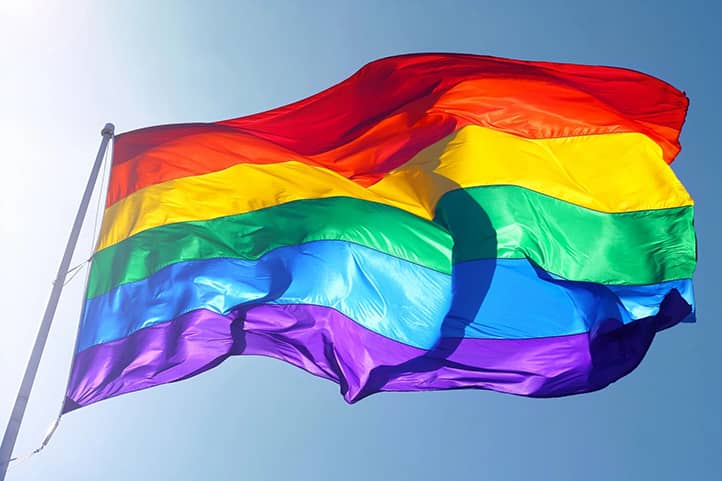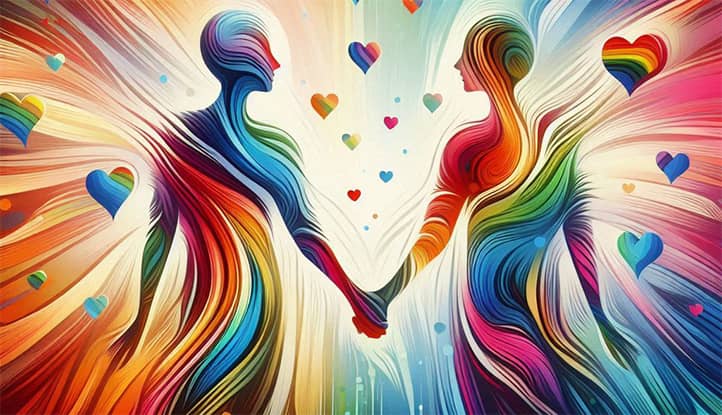Homosexuality is a sexual orientation characterized by emotional, romantic, and/or sexual attraction to people of the same sex. This term applies to both men (gay) and women (lesbians). Bisexuality, the attraction to both sexes, is also often discussed in relation to homosexuality.
Historical attitudes toward homosexuality in society have been complex and varied. In Ancient Greece and Rome, same-sex relationships were widespread and even encouraged in certain contexts. For example, in Ancient Greece, pederasty—relationships between an adult man and a young boy—was considered an important part of educating and socializing young men.
In Medieval Europe, with the spread of Christianity, attitudes toward homosexuality turned strongly negative. Many countries enacted laws criminalizing same-sex relationships. For instance, in England, “sodomy” was punishable by death from 1533 to 1861.
In the 20th century, the process of decriminalizing and destigmatizing homosexuality gradually began. The Stonewall Riots of 1969 in New York are considered the start of the modern LGBT movement. In 1973, the American Psychiatric Association removed homosexuality from the list of mental disorders, a significant step toward recognizing it as a variation of normal.
Today, there is a trend toward greater tolerance and recognition of LGBT rights, although negative attitudes persist in some countries and cultures. According to the International Lesbian, Gay, Bisexual, Trans, and Intersex Association (ILGA), as of 2021, same-sex relations are legal in 69 countries, and same-sex marriage is allowed in 28 countries.

Homosexual Behavior and Sexual Orientation
Human sexuality is a complex mosaic of attractions, behaviors, and identities. Each component of this mosaic can exist independently, creating unique combinations and shades of sexual experience.
Cultural context plays a significant role in interpreting and expressing sexual behavior. What is seen as a sign of homosexuality in one society may be considered a norm in another.
Time perspective is also important when considering homosexual behavior and orientation. Sexual preferences may change over a person’s life, which challenges the concept of a fixed sexual orientation.
Differences Between Behavior and Orientation
It is important to distinguish homosexual behavior from homosexual orientation. Homosexual behavior may be observed in people with different sexual orientations under certain circumstances, such as in single-gender, closed communities like prisons or military institutions. This phenomenon is known as “situational homosexuality.”
In contrast, homosexual orientation is a stable characteristic of a person that does not depend on external circumstances. It includes not only sexual attraction but also romantic feelings, emotional attachment, and self-identification.
The Sexuality Continuum (Kinsey Scale)
American biologist and sexologist Alfred Kinsey, in his groundbreaking studies of human sexual behavior in the 1940s and 1950s, proposed a scale of sexual orientation. This scale, known as the Kinsey Scale, presents sexuality as a continuum from 0 (exclusively heterosexual behavior) to 6 (exclusively homosexual behavior).
The Kinsey Scale includes the following gradations:
- 0 – Exclusively heterosexual.
- 1 – Predominantly heterosexual, only incidentally homosexual.
- 2 – Predominantly heterosexual, but more than incidentally homosexual.
- 3 – Equally heterosexual and homosexual.
- 4 – Predominantly homosexual, but more than incidentally heterosexual.
- 5 – Predominantly homosexual, only incidentally heterosexual.
- 6 – Exclusively homosexual.
Kinsey’s research showed that sexual orientation is not always a strictly binary category, and many people occupy intermediate positions on this scale.
Formation of Sexual Identity
The process of forming a sexual identity among homosexual people often includes several stages. In 1979, psychologist Vivienne Cass proposed a model of homosexual identity formation that includes six stages:
- Identity Confusion: The person begins to realize that their feelings or behavior could be classified as homosexual.
- Identity Comparison: The person starts considering the possibility of being homosexual.
- Identity Tolerance: The person acknowledges the probability of being homosexual and begins to seek other LGBT people.
- Identity Acceptance: The person accepts, rather than merely tolerates, their homosexual identity.
- Identity Pride: The person openly shares their identity with others and feels pride in their LGBT identity.
- Identity Synthesis: The homosexual identity is integrated with other aspects of the personality.
This process can be complex and emotionally intense, especially in societies where homosexuality is stigmatized.

Biological Aspects
Epigenetics opens new horizons in understanding the biological basis of sexuality. Changes in gene expression due to environmental influences may play a key role in shaping sexual orientation, bridging the gap between nature and nurture.
Evolutionary biology offers intriguing hypotheses about the preservation of homosexuality in populations. Perhaps genes associated with homosexuality provide other adaptive advantages that outweigh their impact on reproduction.
The human microbiome – the trillions of microorganisms inhabiting our bodies—may also affect sexual behavior and orientation. Studies indicate that gut bacteria may influence mood, behavior, and even partner choice.
Genetic Factors
Studies suggest that genetics plays a role in determining sexual orientation. Family and twin studies indicate that homosexuality has a degree of heritability.
One of the largest genetic studies on sexual orientation, published in the journal Science in 2019, analyzed data from nearly 500,000 people. Researchers identified five genetic markers associated with same-sex sexual behavior. However, these markers account for only a small part of the variation in sexual behavior, indicating a complex interaction between genetic and environmental factors.
Hormonal Influences
Some scientists believe that the level of prenatal exposure to certain hormones, especially testosterone, may influence sexual orientation. This hypothesis is based on observations that certain physical characteristics associated with prenatal hormone exposure (e.g., finger-length ratios) may differ between homosexual and heterosexual individuals.
A study published in Proceedings of the National Academy of Sciences in 2018 found that levels of certain hormones in amniotic fluid might be associated with sexual orientation in boys. However, this theory remains controversial and requires further research.
Neurobiological Studies
Brain research has revealed some structural and functional differences between homosexual and heterosexual individuals. For example, a study published in Proceedings of the National Academy of Sciences in 2008 found that homosexual men and heterosexual women had similar brain activation patterns in response to certain pheromones, which differed from those of heterosexual men.
Another study, published in Human Brain Mapping in 2019, identified differences in brain connectivity between homosexual and heterosexual men. However, interpreting these differences remains a topic of debate, and it is unclear whether they are a cause or a consequence of sexual orientation.
Homosexual Behavior in Animals
Homosexual behavior is observed in many animal species, including mammals, birds, reptiles, and insects, suggesting that such behavior is part of natural diversity.
Some well-known examples include:
- Bonobos: These primates, close relatives of chimpanzees, regularly display homosexual behavior as part of social interactions.
- Lions: Same-sex sexual contacts have been observed in both male and female lions.
- Penguins: Cases of same-sex pair bonding and even “adoption” of eggs by homosexual penguin pairs have been documented in zoos.
- Dolphins: They exhibit diverse sexual behavior, including homosexual contacts.
Evolutionary Theories
Several theories attempt to explain the evolutionary role of homosexuality:
- Kin Selection Hypothesis: This theory suggests that homosexual individuals may enhance the fitness of their close relatives by helping them raise offspring.
- Sexual Antagonistic Selection Theory: This proposes that genes linked to homosexuality in one sex may increase reproductive success in the other sex.
- Social Bonding Hypothesis: This suggests that homosexual behavior may play a role in strengthening social ties and alliances within groups.
- Balanced Polymorphism Hypothesis: This theory proposes that genes associated with homosexuality may offer other survival benefits that outweigh any potential impact on reproduction.
It is important to note that these theories are not mutually exclusive, and homosexuality may have multiple evolutionary explanations.

Psychological Aspects
The concept of psychological androgyny suggests that integrating both masculine and feminine psychological traits may be associated with greater flexibility in sexual orientation and higher levels of psychological well-being.
The theory of emotional intelligence offers a new perspective on the formation of romantic and sexual preferences. The ability to understand and manage emotions may play a key role in the development and expression of sexual orientation.
Virtual reality and digital technologies are creating new spaces for exploring sexuality and identity. Online communities and virtual worlds provide a safe environment for experimenting with gender expression and sexual orientation.
Formation of Sexual Orientation
Psychological theories on the formation of sexual orientation include the influence of early childhood experiences, family dynamics, and social learning. However, most contemporary psychologists believe that sexual orientation is formed under the influence of a complex interaction of biological, psychological, and social factors.
Erik Erikson’s psychosocial development theory suggests that sexual identity formation occurs during adolescence and early adulthood, when individuals explore their identity and establish intimate relationships.
Psychological Well-Being of LGBTQ+ People
LGBTQ+ individuals often face unique psychological challenges related to stigmatization, discrimination, and internalized homophobia. Research indicates that LGBTQ+ youth are at a higher risk of depression, anxiety, and suicidal thoughts compared to their heterosexual peers.
The concept of “minority stress,” proposed by Ilan Meyer, explains how chronic stigmatization and discrimination can negatively impact the mental health of LGBTQ+ people.
A supportive environment and access to psychological help play a crucial role in ensuring psychological well-being. Studies show that LGBTQ+ people with family and community support demonstrate better mental health outcomes.

Psychiatry and Psychology
Positive psychology offers a new approach to understanding the psychological well-being of LGBTQ+ people, focusing on strengths, resilience, and factors that promote flourishing rather than solely on overcoming the negative effects of stigmatization.
Brain neuroplasticity opens new perspectives on understanding sexual orientation. The brain’s ability to change and adapt throughout life challenges the notion of the immutability of sexual orientation.
Integrative approaches in psychotherapy, combining elements of cognitive-behavioral, psychodynamic, and systemic therapy, offer comprehensive support strategies for LGBTQ+ clients, considering their unique life experiences and cultural context.
History of Attitudes Towards Homosexuality in Psychiatry
Until 1973, homosexuality was classified as a mental disorder in the Diagnostic and Statistical Manual of Mental Disorders (DSM). This period was marked by attempts to “treat” homosexuality through various methods, including psychoanalysis, aversion therapy, and even lobotomy.
Key Moments in Changing Psychiatric Attitudes Towards Homosexuality:
- 1957. Psychologist Evelyn Hooker publishes a study showing that homosexual men do not differ psychologically from heterosexual men.
- 1973. The American Psychiatric Association (APA) removes homosexuality from DSM-II.
- 1975. The American Psychological Association adopts a resolution supporting the removal of homosexuality from the list of mental disorders.
- 1987. The diagnosis of “ego-dystonic homosexuality” (a condition where a person does not accept their sexual orientation) is also removed from DSM-III-R.
- 1992.The World Health Organization (WHO) removes homosexuality from the International Classification of Diseases (ICD-10).
This reclassification marked an important step in recognizing homosexuality as a normal variant and helped reduce LGBTQ+ stigmatization.
Modern Perspectives and Approaches
Modern psychiatry and psychology view homosexuality as a normal variant of human sexuality. The focus has shifted to supporting the mental health of LGBTQ+ people and addressing the negative effects of stigmatization.
Key Aspects of the Modern Approach:
- Recognition of Diversity. Sexual orientation is viewed as a continuum rather than a binary category.
- Affirmative Therapy. Psychotherapeutic approaches that affirm LGBTQ+ clients’ identities.
- Intersectionality. Consideration of the interaction of different aspects of identity (race, class, gender, sexual orientation) in therapeutic work.
- Opposition to Conversion Therapy. Many professional organizations condemn conversion therapy practices aimed at changing sexual orientation as unethical and potentially harmful.
Psychotherapy for LGBTQ+ Clients
Affirmative psychotherapy for LGBTQ+ clients aims to support positive self-identity and address issues related to social stigmatization. Key principles of such therapy include:
- Recognizing the impact of social stigma on mental health.
- Providing support during the coming-out process and identity formation.
- Helping to overcome internalized homophobia.
- Strengthening connections with the LGBTQ+ community.
- Working with families of LGBTQ+ clients to improve support.
Studies show that affirmative psychotherapy can significantly improve the psychological well-being of LGBTQ+ people.

Homosexuality and Science
Interdisciplinary research that combines advancements in neuroscience, genetics, endocrinology, and psychology creates a more comprehensive picture of the biological and social factors influencing sexual orientation.
The development of artificial intelligence and machine learning technologies offers new possibilities for analyzing large volumes of data on sexual behavior and orientation, allowing for the identification of hidden patterns and correlations.
The ethics of sexual orientation research has become increasingly important with advances in genetic technology. The potential to predict sexual orientation based on genetic markers raises serious ethical issues regarding privacy and potential discrimination.
Overview of Scientific Research
Scientific research on homosexuality spans a wide range of disciplines, including biology, psychology, sociology, and anthropology. Key areas of research:
- Epidemiology. Study of the prevalence of homosexuality in the population. Different studies estimate the proportion of people identifying as LGBTQ+ to range from 1.2% to 6.8%, depending on methodology and definitions.
- Neurobiology. Research on brain structures and functions related to sexual orientation. For instance, Simon LeVay’s 1991 study identified differences in the size of certain hypothalamic structures in homosexual and heterosexual men.
- Genetics. Search for genetic markers associated with sexual orientation. A large-scale study published in Science in 2019 identified several genetic loci associated with same-sex behavior.
- Endocrinology. Study of the role of hormones in the formation of sexual orientation, including prenatal hormonal influences.
- Psychosocial Research. Study of the influence of social factors on the formation and expression of sexual orientation, as well as the psychological well-being of LGBTQ+ people.
Criticism and Limitations of Research
Many studies on homosexuality face methodological challenges, including:
- Difficulties in defining and measuring sexual orientation. Different studies may use different criteria (behavior, attraction, self-identification), making it challenging to compare results.
- Sampling issues. LGBTQ+ people may be less inclined to participate in studies due to fear of stigmatization, potentially leading to sampling bias.
- Cultural specificity. Many studies are conducted in Western countries, and their results may not apply to other cultures.
- Difficulty separating biological and social factors. It is challenging to determine whether observed differences are a cause or effect of sexual orientation.
- Ethical constraints. Certain types of experimental research may be unethical, limiting the ability to study causal relationships.
Ethical Issues in Sexuality Research
Research on sexuality raises important ethical considerations, including:
- Confidentiality. Protecting the personal information of research participants is crucial, given the potential social risks of disclosing sexual orientation.
- Informed Consent. Participants should fully understand the aims and potential risks of the research.
- Minimizing Harm. Researchers should avoid reinforcing stigmatization or discrimination against LGBTQ+ people.
- Fair Representation of Results. It is important to avoid sensationalism and misinterpretation of data, especially in the media.
- Policy Influence. Research findings can impact public opinion and policy, placing additional responsibility on researchers.

Myths and Misconceptions about Homosexuality
Unfortunately, myths and misconceptions about homosexuality are still widespread in society. One of the most persistent is the belief that homosexuality is a choice or a “lifestyle.” However, scientific research shows that sexual orientation is shaped by a complex mix of biological and environmental factors. It is not a matter of conscious decision-making but a fundamental part of a person’s identity.
Another dangerous misconception is the association of homosexuality with pedophilia. This myth has no scientific basis and causes enormous harm to the LGBTQ+ community. Research has repeatedly shown that sexual orientation is not linked to any inclination toward pedophilia. It is crucial to actively combat this stereotype, as it is often used to incite hatred and discrimination.
Another myth is the idea that homosexuality results from “wrong” parenting. Scientific research does not support this theory. Sexual orientation is influenced by a complex interplay of factors, including genetic and hormonal ones, and does not depend on parenting style or childhood trauma.
Another common misconception is the myth of the “gaydar” or the ability of homosexual people to accurately determine others’ sexual orientation. In reality, sexual orientation is not connected to any external traits or behavioral patterns that can be reliably identified.
There is also a myth that in same-sex relationships, one partner necessarily takes on a “male” role, and the other a “female” role. This simplified and stereotypical view does not reflect the reality of homosexual relationships, which are as diverse as heterosexual ones.
Another misconception concerns bisexuality. Many mistakenly believe that bisexuality is a “phase” or an inability to “decide.” In reality, bisexuality is a full and stable sexual orientation.
There is also the myth that homosexual people cannot be good parents. However, numerous studies show that children raised by same-sex couples develop just as successfully as children of heterosexual parents. The quality of parenting depends on love, care, and attention to the child, not the parents’ sexual orientation.
Finally, there is the myth that HIV/AIDS is a “gay disease.” Although the LGBTQ+ community was historically heavily affected by the HIV epidemic, the virus can be transmitted to anyone, regardless of sexual orientation. It is important to understand that the risk of infection is related to behavior, not sexual orientation.
Debunking these and other myths is essential for combating discrimination and stigmatization of LGBTQ+ people. Education and the dissemination of scientifically grounded information play a key role in shaping a more inclusive and understanding society.

Homosexuality in Culture and Art
LGBTQ+ themes have a rich history in literature. From the ancient Greek poetry of Sappho to the works of Oscar Wilde and Virginia Woolf, homosexual motifs have always been present in world literature, though often in veiled forms. In the 20th century, especially after the 1969 Stonewall riots, LGBTQ+ themes began to be more openly represented in literature.
In cinema, the representation of LGBTQ+ characters has had a complicated path. From hidden subtexts in classic Hollywood films to contemporary movies that openly explore themes of homosexuality, cinema has come a long way. Films such as Brokeback Mountain and Moonlight not only received critical acclaim but also contributed to broader societal discussions about LGBTQ+ issues.
Queer art occupies a special place in contemporary art. This genre explores gender, sexuality, and LGBTQ+ identity. Artists working in this direction often challenge traditional views of gender and sexuality, using their art as a tool for social change.

Homosexuality and Religion
Attitudes toward homosexuality vary widely among different religious traditions, ranging from full rejection to acceptance and inclusivity. In Christianity, for example, positions differ greatly among denominations: from conservative views condemning homosexuality to liberal interpretations that fully accept LGBTQ+ believers.
In recent decades, LGBTQ+-inclusive religious movements have been growing. Some Christian denominations, such as the United Church of Christ, fully embrace LGBTQ+ people, including them in church ministry and blessing same-sex marriages. In Judaism, the Reform movement is also open to LGBTQ+ believers. In Islam, although traditional interpretations remain conservative, there are movements pushing for a more inclusive interpretation of religious texts.
Religious LGBTQ+ organizations play an important role in this process. Groups such as Dignity for LGBTQ+ Catholics or Keshet for LGBTQ+ Jews provide support and create safe spaces for believers seeking to reconcile their sexual orientation with their religious identity. These organizations also work to change attitudes toward LGBTQ+ people within their religious communities.

Prominent LGBTQ+ Individuals
LGBTQ+ representatives in technology and innovation are increasingly visible. Openly gay and lesbian individuals hold key positions in leading tech companies, contributing to more inclusive work environments and developing products that take into account the needs of the LGBTQ+ community.
LGBTQ+ athletes challenge gender stereotypes and homophobia in the sports world. Their openness and achievements contribute to greater acceptance of diversity in traditionally conservative sports environments.
The number of openly LGBTQ+ politicians in high-level government positions around the world is also increasing. Their presence in government helps advance equal rights legislation and combat systemic discrimination.
Many prominent figures in history and modernity were or are openly members of the LGBTQ+ community. Their contributions across various fields have helped raise visibility and acceptance of LGBTQ+ people.
Historical Figures
- Oscar Wilde: Irish writer and poet. His works, such as The Picture of Dorian Gray, have become classics of world literature. Wilde was convicted of “gross indecency” because of his relationships with men, leading to two years of hard labor.
- Alan Turing: British mathematician and cryptographer, who played a key role in deciphering the German “Enigma” code during World War II. Considered one of the founders of computer science and artificial intelligence. He was convicted for homosexual relations and subjected to chemical castration.
- Frida Kahlo: Mexican artist known for her vibrant self-portraits and works inspired by nature and Mexican culture. She was bisexual and had relationships with both men and women.
- Virginia Woolf: British writer, a key figure in 20th-century modernist literature. Her novel Orlando is considered one of the earliest explorations of gender identity in literature. She had romantic relationships with women, particularly writer Vita Sackville-West.
Modern Celebrities
- Elton John: British singer, pianist, and composer. One of the most commercially successful performers in history. He came out as gay in 1988 and has become a prominent activist in the fight against AIDS.
- Ellen DeGeneres: American comedian, actress, and television host whose coming out in 1997 was a milestone in LGBTQ+ representation on television. Her show Ellen was one of the first with an openly gay main character.
- Tim Cook: CEO of Apple Inc. Came out as gay in 2014, becoming the first openly gay CEO of a Fortune 500 company.
- Laverne Cox: American actress and LGBTQ+ activist. The first openly transgender woman nominated for a Primetime Emmy Award as an actress. Known for her role in Orange Is the New Black and her activism for transgender rights.
- Ricky Martin: Puerto Rican singer and actor. After coming out in 2010, he became a prominent LGBTQ+ activist, especially within the Latin American community.
Influence on Public Opinion
The openness of public figures about their sexual orientation can greatly influence public opinion and contribute to the normalization of homosexuality. Studies show that personal acquaintance with LGBTQ+ people, including through media, is associated with more positive attitudes toward the LGBTQ+ community as a whole.
For example, after actress Ellen DeGeneres came out in 1997, there was a significant increase in LGBTQ+ character representation on television. This, in turn, contributed to greater visibility and acceptance of LGBTQ+ people in society.
Politicians and public figures who are open about their homosexuality also play an important role in advancing LGBTQ+ rights. For example, Pete Buttigieg, an openly gay former mayor of South Bend and a U.S. presidential candidate, helped normalize the image of LGBTQ+ politicians in American society.

Conclusion
Homosexuality is a complex and multifaceted aspect of human sexuality. Scientific research shows that it is a natural variation of sexual orientation, shaped by a complex interplay of biological, psychological, and social factors.
Despite significant progress in recognizing LGBTQ+ rights in many countries, issues of discrimination and stigmatization persist. Ongoing research and public dialogue play a vital role in overcoming prejudice and creating a more inclusive society.
Understanding and accepting the diversity of human sexuality is a key step toward building a society where all people, regardless of their sexual orientation, can live freely and with dignity. It is important to continue educational efforts, fight discrimination, and support equal rights for all members of society.




